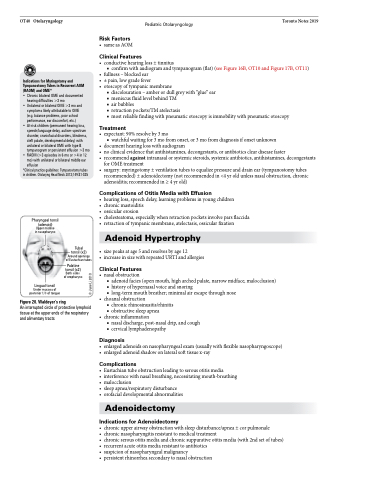Page 1026 - TNFlipTest
P. 1026
OT40 Otolaryngology
Pediatric Otolaryngology Toronto Notes 2019
Indications for Myringotomy and Tympanostomy Tubes in Recurrent AOM (RAOM) and OME*
• Chronic bilateral OME and documented
hearing difficulties >3 mo
• Unilateral or bilateral OME >3 mo and
symptoms likely attributable to OME (e.g. balance problems, poor school performance, ear discomfort, etc.)
• At-risk children (permanent hearing loss, speech/language delay, autism-spectrum disorder, craniofacial disorders, blindness, cleft palate, developmental delay) with unilateral or bilateral OME with type B tympanogram or persistent effusion >3 mo
• RAOM(>3episodesin6moor>4in12 mo) with unilateral or bilateral middle ear effusion
*Clinical practice guidelines: Tympanostomy tubes in children. Otolaryng Head Neck 2013;149:S1-S35
Risk Factors
• sameasAOM
Clinical Features
• conductivehearingloss±tinnitus
■ confirm with audiogram and tympanogram (flat) (see Figure 16B, OT10 and Figure 17B, OT11)
• fullness–blockedear
• ±pain,lowgradefever
• otoscopyoftympanicmembrane
■ discolouration – amber or dull grey with “glue” ear ■ meniscus fluid level behind TM
■ air bubbles
■ retractionpockets/TMatelectasis
■ most reliable finding with pneumatic otoscopy is immobility with pneumatic otoscopy
Treatment
• expectant:90%resolveby3mo
■ watchful waiting for 3 mo from onset, or 3 mo from diagnosis if onset unknown
• documenthearinglosswithaudiogram
• noclinicalevidencethatantihistamines,decongestants,orantibioticscleardiseasefaster
• recommendagainstintranasalorsystemicsteroids,systemicantibiotics,antihistamines,decongestants
for OME treatment
• surgery: myringotomy ± ventilation tubes to equalize pressure and drain ear (tympanostomy tubes
recommended) ± adenoidectomy (not recommended in <4 yr old unless nasal obstruction, chronic adenoiditis; recommended in ≥ 4 yr old)
Complications of Otitis Media with Effusion
• hearingloss,speechdelay,learningproblemsinyoungchildren
• chronicmastoiditis
• ossicularerosion
• cholesteatoma,especiallywhenretractionpocketsinvolveparsflaccida • retractionoftympanicmembrane,atelectasis,ossicularfixation
Adenoid Hypertrophy
• sizepeaksatage5andresolvesbyage12
• increaseinsizewithrepeatedURTIandallergies
Clinical Features
• nasalobstruction
■ adenoid facies (open mouth, high arched palate, narrow midface, malocclusion) ■ history of hypernasal voice and snoring
■ long-term mouth breather; minimal air escape through nose
• choanalobstruction
■ chronic rhinosinusitis/rhinitis ■ obstructive sleep apnea
• chronicinflammation
■ nasal discharge, post-nasal drip, and cough ■ cervical lymphadenopathy
Diagnosis
• enlargedadenoidsonnasopharyngealexam(usuallywithflexiblenasopharyngoscope) • enlargedadenoidshadowonlateralsofttissuex-ray
Complications
• Eustachiantubeobstructionleadingtoserousotitismedia
• interferencewithnasalbreathing,necessitatingmouth-breathing • malocclusion
• sleepapnea/respiratorydisturbance
• orofacialdevelopmentalabnormalities
Adenoidectomy
Indications for Adenoidectomy
• chronicupperairwayobstructionwithsleepdisturbance/apnea±corpulmonale
• chronicnasopharyngitisresistanttomedicaltreatment
• chronicserousotitismediaandchronicsuppurativeotitismedia(with2ndsetoftubes) • recurrentacuteotitismediaresistanttoantibiotics
• suspicionofnasopharyngealmalignancy
• persistentrhinorrheasecondarytonasalobstruction
Pharyngeal tonsil (adenoid) Upper midline
in nasopharynx
Lingual tonsil Under mucosa of posterior 1/3 of tongue
Tubal tonsil (x2) Around openings of Eustachian tubes
Palatine tonsil (x2) Both sides of oropharynx
Figure 20. Waldeyer’s ring
An interrupted circle of protective lymphoid tissue at the upper ends of the respiratory and alimentary tracts
© June Li 2010


